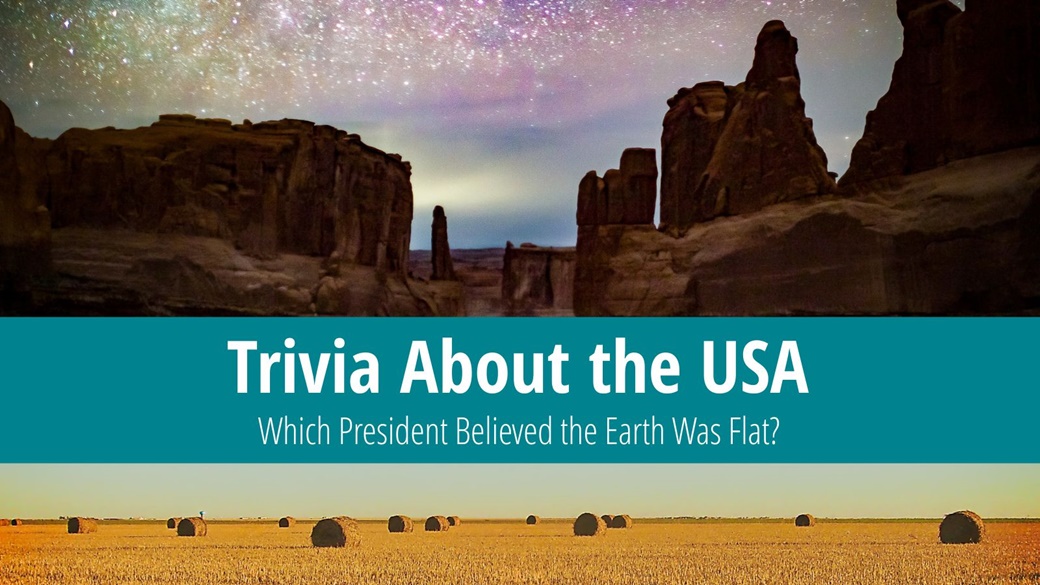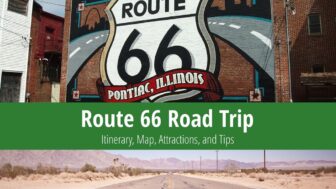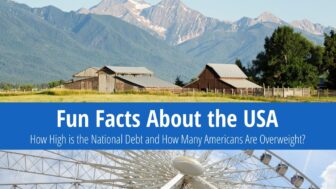Did you know that the United States of America planned to detonate a nuclear device on the Moon in the 1950s, and that there are only two escalators in the entire state of Wyoming? Keep reading to discover all the details, including links to verified sources. You’ll also learn that the smallest park in the country is no bigger than an office chair and that a town in Alaska once appointed a cat named Stubbs as its honorary mayor.

-
Table of Contents
- There Are Only Two Escalators in All of Wyoming
- The U.S. Planned to Detonate a Nuclear Bomb on the Moon
- The Smallest Park in the U.S. Is the Size of an Office Chair
- A Cat Named Stubbs Was Honorary Mayor of Talkeetna
- The Mississippi River Changed Course and Cut Off Kaskaskia from the Rest of Illinois
- Michigan Is Home to the Only Floating Post Office in the U.S.
- Ohio Is the Only State Without a Rectangular Flag
- The Smallest Town in the U.S. Has Only One Resident
- There Is a U.S. Zone Where All Electronic Signals Are Banned
- Massachusetts Lake Has the Longest Place Name in the U.S.
- Key West Declared Independence From the U.S. in 1982
- Underground Fire Has Been Burning in Pennsylvania Since 1962
- There Is a Spelling Mistake on the Famous Liberty Bell
- There Is a Place in Idaho Where Crimes Can Go Unpunished
- Philadelphia Was Once the Temporary Capital of the United States
- The Largest Mall in the United States Is Bigger Than the Vatican
- There Are More Bourbon Barrels Than People in Kentucky
- Eight U.S. Presidents Were Born in Virginia
- One U.S. State Was Once a Kingdom
- Lake Superior Is the Largest Freshwater Lake in the World
- The American Flag Has Been Changed 26 Times
- 90% of U.S. Corn Comes from the Corn Belt
- The Current U.S. Flag Was Designed by a 17-Year-Old Student
- Wrangell–St. Elias National Park Is Bigger Than an Entire Country
- The U.S. National Anthem Was Written on the Back of a Letter
There Are Only Two Escalators in All of Wyoming
Wyoming is the tenth-largest state in the U.S. by area, measuring 97,818 sqmi, yet it has only two escalators. Both are located in the city of Casper—one in the First National Bank and the other in the Hilltop National Bank.
This surprisingly low number is due to the state’s low population density and predominantly rural character. In multi-story buildings, Wyoming residents tend to rely on elevators or stairs instead.
-
The U.S. Planned to Detonate a Nuclear Bomb on the Moon
In the late 1950s, the U.S. Air Force launched a top-secret program called Project A119, which aimed to detonate a nuclear device on the Moon to study the effects of a nuclear explosion in low-gravity conditions. Scientists expected the mushroom cloud to be visible from Earth, serving as a demonstration of American power during the Cold War.
Project A119 was ultimately canceled due to concerns about possible contamination, negative public reaction, and the risk of failing to achieve any tangible benefit. Official documents related to the project remained classified for decades.
-
The Smallest Park in the U.S. Is the Size of an Office Chair
Mill Ends Park is the smallest officially recognized park in the United States. It is located in the heart of Portland, Oregon, and has a diameter of just 61 cm, roughly the size of an office chair.
The publicly accessible Mill Ends Park was created in 1948 by local journalist Dick Fagan, who planted flowers in a spot originally intended for a light pole. Over time, it became a quirky local attraction drawing curious visitors.
-
A Cat Named Stubbs Was Honorary Mayor of Talkeetna
Talkeetna is a small town in Alaska that serves as a gateway to Denali National Park. In 2020, its population was just 1,055. In 1997, a cat named Stubbs was appointed as the town’s honorary mayor and quickly became beloved by both locals and tourists.
Stubbs brought attention to Talkeetna, received fan mail, and regularly greeted tourists at a local shop. He served as honorary feline mayor until his death in 2017.
-
The Mississippi River Changed Course and Cut Off Kaskaskia from the Rest of Illinois
In the 18th century, Kaskaskia, Illinois, was a thriving French colonial settlement along the Mississippi River and even served as the state’s first capital. Over time, however, the Mississippi River shifted course, effectively placing the town on the western bank—although it legally remains part of Illinois.
Today, Kaskaskia is a small village with only 23 residents as of 2023, and it can only be reached via Missouri. It remains a unique geographic anomaly within the United States.
-
Michigan Is Home to the Only Floating Post Office in the U.S.
The vessel J. W. Westcott II delivers mail and packages to ships on the Detroit River, making it the only floating post office in the United States. This waterborne post office even has its own ZIP Code: 48222.
In continuous operation since 1874, the service was founded by Captain John Ward Westcott, who initially delivered mail manually by boat. The current vessel, J. W. Westcott II, has been in service since 1949 and is operated by the Westcott Company, a family-owned business.
-
Ohio Is the Only State Without a Rectangular Flag
Ohio is the only U.S. state with a swallowtail-shaped flag instead of the traditional rectangle. The flag was designed by Cleveland architect John Eisenmann for the Ohio state pavilion at the Pan-American Exposition.
The Ohio state flag was officially adopted on May 9, 1902. Its distinctive triangular cut is known as a “burgee” and is commonly associated with nautical pennants. The flag’s seventeen stars represent Ohio’s admission as the 17th state in the Union. The red, white, and blue colors symbolize the national colors of the United States.
-
The Smallest Town in the U.S. Has Only One Resident
Buford, located in Wyoming, was once known as the smallest town in America, with just a single resident for many years. Despite its tiny population, Buford had a store and a gas station. In 2012, the town’s sole resident put the entire town up for auction, including 10 acres of land and all of its buildings.
The town was sold for $900,000 (equivalent to $1,251,422 in 2025 prices) to an entrepreneur from Vietnam, who later renamed it “PhinDeli Town Buford”.
-
There Is a U.S. Zone Where All Electronic Signals Are Banned
Across parts of West Virginia, Virginia, and Maryland lies the National Radio Quiet Zone (NRQZ), spanning approximately 13,127 sqmi. Within this area, mobile signals, radio transmissions, Wi-Fi, and other wireless communications are heavily restricted.
The zone was established in 1958 by the Federal Communications Commission to minimize radio interference near the Green Bank Observatory, which houses one of the world’s largest fully steerable radio telescopes. Compliance with wireless transmission restrictions is enforced by so-called radio police.
-
Massachusetts Lake Has the Longest Place Name in the U.S.
Lake Chargoggagoggmanchauggagoggchaubunagungamaugg in the town of Webster, Massachusetts, holds the record for the longest place name in the United States. The 45-letter name comes from the language of the Nipmuc tribe and is often translated as “You fish on your side, I fish on mine, and nobody fishes in the middle.”
Locals typically shorten the name to “Lake Chaubunagungamaug” or simply “Lake Webster”.
-
Key West Declared Independence From the U.S. in 1982
In 1982, residents of Key West, Florida, humorously declared independence from the United States and called themselves the Conch Republic. This unusual act was a protest against highway checkpoints set up by the U.S. Border Patrol, which caused significant traffic issues for both locals and tourists.
Immediately after the declaration, the mayor held a mock secession ceremony—and one minute later symbolically surrendered to a Navy officer. In the meantime, residents requested $1 billion in foreign aid, imitating typical requests made by newly formed nations.
The Conch Republic has since lived on as a tongue-in-cheek brand, complete with its own flag, passports, and a strong sense of local pride.
-
Underground Fire Has Been Burning in Pennsylvania Since 1962
Centralia is a ghost town in northeastern Pennsylvania that was once a well-known coal mining hub. In 1962, a fire broke out at a local landfill and unintentionally spread to abandoned coal seams beneath the town. The underground blaze began releasing toxic gases and causing ground collapses, ultimately rendering Centralia uninhabitable.
Over the following decades, the federal government bought out most of the residents’ homes, and the majority of buildings were demolished. As of 2023, only five residents remained in Centralia, surrounded by cracked roads and smoking vents. Scientists estimate that the underground fire could continue burning for another 250 years at its current rate.
-
There Is a Spelling Mistake on the Famous Liberty Bell
The Liberty Bell is one of the most iconic symbols of freedom and independence in the United States. The bell was cast between 1751 and 1752, and in 1776, it was rung to symbolically affirm the nation’s independence.
Today, the bell is housed in the Liberty Bell Center in Philadelphia, Pennsylvania. Interestingly, the name of the state is cast on the bell as “Pensylvania”, which was an accepted spelling at the time. From a modern perspective, however, it is considered a typographical error, as the official spelling is now “Pennsylvania”.
The bell was originally commissioned to mark the 50th anniversary of the Charter of Privileges, created by William Penn in 1701. Notably, the bell cracked during its very first ringing. Even recasting it a second time did not resolve the issue, and the bell is therefore no longer used actively.
-
There Is a Place in Idaho Where Crimes Can Go Unpunished
In a remote section of Yellowstone National Park located in the state of Idaho, there is an area spanning approximately 50 sqmi that is nicknamed the “Zone of Death” due to a constitutional loophole. Theoretically, any crime committed in this area could go unpunished if the defendant insisted on a jury composed exclusively of residents from the corresponding judicial district.
According to the Sixth Amendment to the U.S. Constitution, jurors must come from both the district and the state where the crime occurred. However, the “Zone of Death” lacks a sufficient population to form a legally valid jury. This loophole has never been tested in court, making it a unique constitutional anomaly.
-
Philadelphia Was Once the Temporary Capital of the United States
From 1790 to 1800, Philadelphia served as the temporary capital of the United States while the permanent seat of government in Washington, D.C., was still under construction. Philadelphia played a pivotal role during the American Revolutionary War and was the site where both the Declaration of Independence and the U.S. Constitution were signed.
Lawmakers convened in Independence Hall, a publicly accessible building that commemorates key moments in the nation’s history. Independence Hall is a UNESCO World Heritage Site and is featured on the reverse side of the $100 bill.
The first capital of the United States was New York, where the U.S. government was based in 1789 and 1790 after the Constitution was ratified.
-
The Largest Mall in the United States Is Bigger Than the Vatican
The Mall of America in Bloomington, Minnesota, is the largest shopping mall in the United States. Covering an area of 520,000 square meters, it is larger than the entire Vatican. Mall of America even has its own ZIP code, 55425, and is spacious enough to fit seven New York Yankees stadiums.
The mall features more than 500 stores, an amusement park, aquariums, and mini golf. Throughout the year, Mall of America hosts concerts, fashion shows, and other cultural events. The mall attracts over 30 million visitors annually.
-
There Are More Bourbon Barrels Than People in Kentucky
The state of Kentucky is renowned for its bourbon production, with famous brands such as Jim Beam, Woodford Reserve, Maker’s Mark, Buffalo Trace, Wild Turkey, and Four Roses. The unique flavor profile of Kentucky bourbon is shaped by the state’s limestone-rich water and favorable climate.
Kentucky is home to about 4.5 million people, but there are nearly 12 million barrels of bourbon aging in the state. That’s roughly two and a half barrels per resident. Each barrel typically holds 53 U.S. gallons of bourbon, which equals about 200 liters.
-
Eight U.S. Presidents Were Born in Virginia
More U.S. presidents were born in Virginia than in any other state, earning it the nickname “Mother of Presidents”. Seven of the eight Virginia-born presidents held office before 1850.
Notable presidents from Virginia include George Washington (1st president, 1789–1797), Thomas Jefferson (3rd president, 1801–1809), James Madison (4th president, 1809–1817), James Monroe (5th president, 1817–1825), William Henry Harrison (9th president, 1841), John Tyler (10th president, 1841–1845), Zachary Taylor (12th president, 1849–1850), and Woodrow Wilson (28th president, 1913–1921).
-
One U.S. State Was Once a Kingdom
The Kingdom of Hawaii was established in 1795 and lasted until 1893, when Queen Liliʻuokalani was overthrown in a coup supported by the United States. The Hawaiian monarchy had its own flag, national anthem, and official royal seal. At the time, the royal family played a major role in the cultural, political, and economic life of the islands.
The overthrow of the monarchy led to Hawaii’s annexation by the United States in 1898. On August 21, 1959, Hawaii became the 50th U.S. state.
-
Lake Superior Is the Largest Freshwater Lake in the World
Lake Superior is part of the Great Lakes, located along the U.S.–Canada border. Based on surface area, it is the largest freshwater lake in the world, covering 31,699 sqmi and holding 12,087 cubic kilometers of water.
The lake is up to 1,332 ft deep and contains about 10% of the world’s surface fresh water. Lake Superior holds so much water that it could cover the entire landmass of North and South America to a depth of 30 cm.
-
The American Flag Has Been Changed 26 Times
The first version of the American flag was adopted in 1777. It had 13 stripes and 13 stars, representing the original 13 colonies that declared independence from Great Britain. The number of stars on the flag changed every time a new state joined the Union.
The current 27th version of the U.S. flag was adopted on July 4, 1960, after Hawaii became the 50th U.S. state.
-
90% of U.S. Corn Comes from the Corn Belt
The “Corn Belt” is a region in the American Midwest that spans across Illinois, Indiana, Iowa, Missouri, and Nebraska. The United States is one of the world’s largest corn producers, and 90% of all American corn is grown in the Corn Belt.
Corn’s dominance in the Midwest is so significant that it impacts not only the economy but also the region’s cultural and social life, with festivals, markets, and agricultural fairs held throughout the area.
-
The Current U.S. Flag Was Designed by a 17-Year-Old Student
The current design of the U.S. flag was created in 1958 by Robert G. Heft, a 17-year-old high school student at Lancaster High School in Ohio. His design was part of a school project before Hawaii became the 50th U.S. state.
Robert G. Heft’s flag design was selected from over 1,500 submissions and officially adopted on July 4, 1960. Interestingly, even though Heft created one of the most recognizable symbols in the world, he received a B- for the project.
-
Wrangell–St. Elias National Park Is Bigger Than an Entire Country
Wrangell–St. Elias National Park and Preserve in Alaska spans an area of 20,587 sqmi, making it larger than Costa Rica (19,730 sqmi), Switzerland (15,942 sqmi), or the Netherlands (16,164 sqmi). Yellowstone National Park could fit inside Wrangell–St. Elias six times over.
The largest U.S. national park is mostly remote wilderness, featuring tall mountains, glaciers, and deep valleys.
It is home to the longest valley glacier in North America outside the polar regions. The Bagley Icefield stretches more than 127 mi and is up to 2,999 ft thick. The park also includes the Kennecott Mines National Historic Landmark, a preserved ghost town from the early 20th-century copper boom.
-
The U.S. National Anthem Was Written on the Back of a Letter
The author of the U.S. national anthem was lawyer and amateur poet Francis Scott Key. He wrote the lyrics on the back of a letter during the War of 1812 after witnessing a British attack on Fort McHenry in Maryland. He was inspired by the sight of the American flag still flying above the fort after the battle.
The lyrics were later set to music by John Stafford Smith, though it would take decades for the song to become the official national anthem. The Star-Spangled Banner was finally declared the U.S. national anthem in 1931.
Continue reading incredible facts about the USA in the article 35 Amazing Facts About the USA You Must Know.

 10 Best Photo Places in the USA
10 Best Photo Places in the USA




Contribute with Your Question or Personal Experience